Lay vs Lie: Which English Grammar Rule Do You Use?

Written by
Ernest Bio Bogore

Reviewed by
Ibrahim Litinine
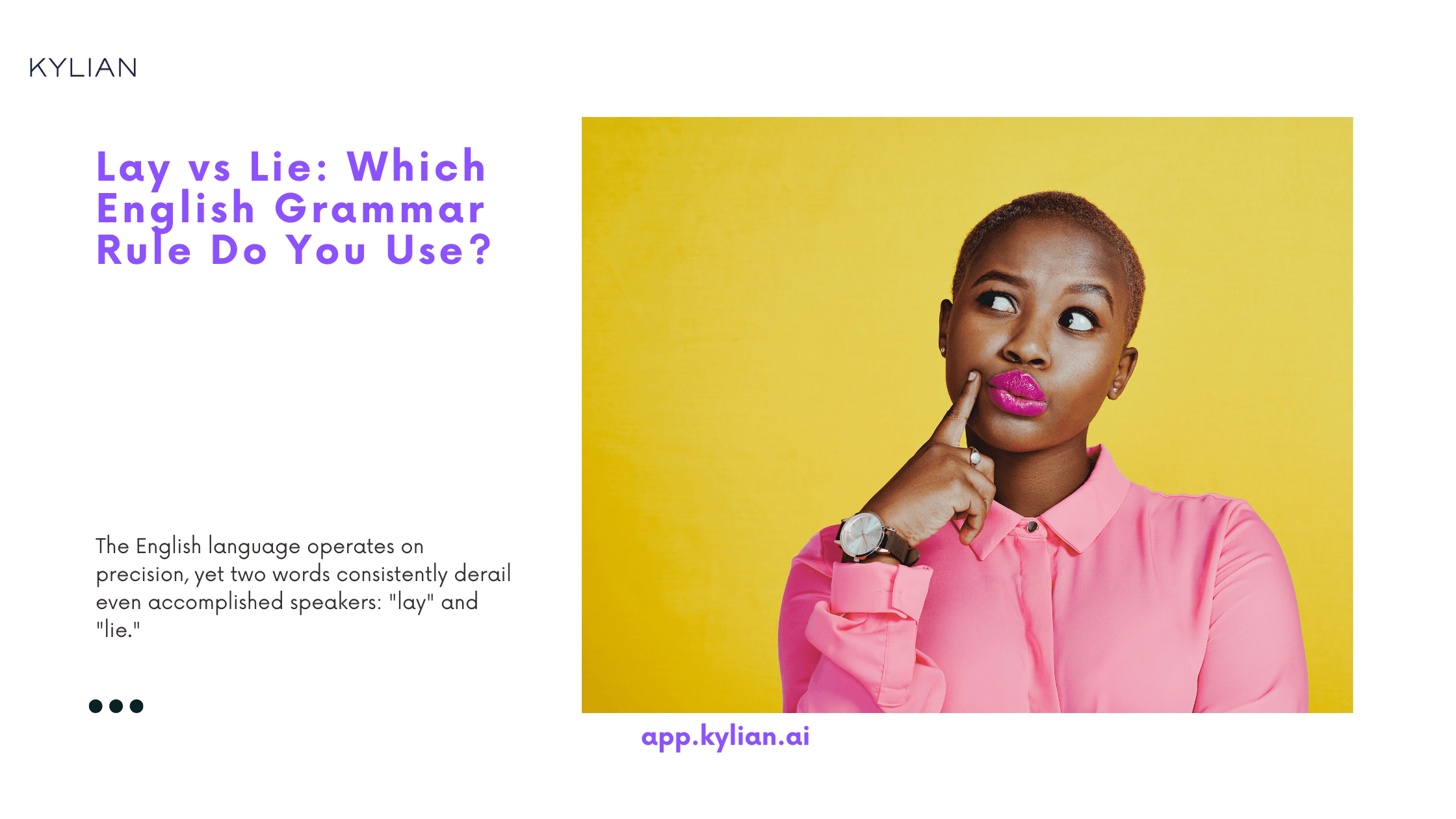
The English language operates on precision, yet two words consistently derail even accomplished speakers: "lay" and "lie." In English, "lay" means to place or put something down in a specific position, requiring a direct object to complete its meaning. Meanwhile, "lie" means to recline or rest in a horizontal position, functioning as an intransitive verb that needs no direct object. This distinction matters because misusing these verbs signals a fundamental misunderstanding of English grammar mechanics—one that undermines credibility in professional and academic contexts.
What's the main difference between 'lay' and 'lie'?
The core distinction operates on grammatical transitivity, a concept that determines how verbs interact with objects in sentences. "Lay" functions as a transitive verb, demanding a direct object to receive the action. When you lay something, you actively place an item somewhere specific. The verb cannot stand alone—it requires completion through an object.
"Lie," conversely, operates as an intransitive verb, describing a state of being rather than an action performed on something else. When you lie down, you position yourself without acting upon another object. The subject performs the action on itself, creating a self-contained grammatical structure.
Consider these examples that illuminate the distinction:
Lay (transitive): "The architect will lay the blueprints on the conference table." Here, "blueprints" receives the action of being placed.
Lie (intransitive): "The architect will lie on the couch after the presentation." The subject (architect) performs the action of reclining without affecting another object.
The confusion intensifies because "lay" serves as both the present tense of the transitive verb and the past tense of "lie." This overlap creates a grammatical maze that traps speakers who haven't mastered the underlying logic.
How and when to use 'lay' and 'lie' with examples?
Understanding application requires recognizing the grammatical signals that determine verb choice. "Lay" appears when you can identify what is being placed or positioned. The sentence structure follows a subject-verb-object pattern, where the object receives the action of placement.
Use "lay" in these contexts:
Present tense: "I lay the documents on your desk every morning." The documents receive the action of being placed.
Past tense: "Yesterday, I laid the foundation for our new strategy." The foundation received the action of being established.
Future tense: "Tomorrow, we will lay new carpet in the office." The carpet will receive the action of being installed.
"Lie" functions when describing positioning without an external object. The sentence structure remains subject-verb, with no direct object receiving action.
Use "lie" in these contexts:
Present tense: "The solution lies in understanding customer behavior." No object receives action; the solution exists in a state.
Past tense: "Last night, I lay awake thinking about the proposal." The subject positioned themselves without acting on another object.
Future tense: "The reports will lie unread until Monday." The reports will exist in a state without external action upon them.
The critical test involves asking whether something is being placed somewhere. If yes, use "lay." If the sentence describes a state of being or self-positioning, use "lie."
More real-life scenarios where 'lay' and 'lie' can be used
Professional environments demand grammatical precision, making these distinctions particularly consequential in business communication.
Scenario 1 - Corporate Strategy Meeting: During quarterly planning, the CEO might say, "We need to lay our priorities on the table and examine each initiative thoroughly." This usage correctly employs "lay" because priorities (the direct object) are being placed (metaphorically) on the table for examination. The transitive nature becomes clear—the priorities receive the action of being presented.
Scenario 2 - Medical Consultation: A physician instructing a patient would say, "Please lie on the examination table while I review your test results." Here, "lie" correctly describes the patient's self-positioning without acting upon another object. The patient assumes a reclined position through their own action, making the verb intransitive.
Scenario 3 - Construction Project Management: A site supervisor coordinating work might declare, "The crew will lay the electrical conduits before installing the flooring system." This demonstrates "lay" in its transitive function—conduits (direct object) receive the action of being positioned. The sentence structure clearly shows subject (crew) performing action (lay) on object (conduits).
Scenario 4 - Legal Documentation: An attorney reviewing case precedents might observe, "The burden of proof lies with the prosecution to establish guilt beyond reasonable doubt." This exemplifies "lie" in its intransitive capacity—the burden exists in a state or position without receiving external action. No direct object receives the action; instead, the burden occupies a conceptual location.
These scenarios reveal how grammatical precision affects professional credibility. Misusing these verbs in formal contexts signals carelessness with language fundamentals.
Common mistakes to avoid when using 'lay' and 'lie'
Two primary errors dominate incorrect usage patterns, both stemming from misunderstanding transitivity requirements.
Mistake 1: Using "lay" without a direct object Incorrect: "I'm tired, so I'm going to lay down for thirty minutes." Correct: "I'm tired, so I'm going to lie down for thirty minutes."
This error occurs because speakers confuse the transitive nature of "lay." When you "lay down," grammatically you must lay something down. Since no object exists in the incorrect example, "lie" becomes the appropriate choice. The confusion amplifies because "lay down" sounds natural to many speakers, despite being grammatically incomplete.
Mistake 2: Past tense confusion with "laid" and "lay" Incorrect: "Yesterday, I laid on the beach reading financial reports." Correct: "Yesterday, I lay on the beach reading financial reports."
This mistake emerges from the overlapping conjugations. "Laid" serves as the past tense of the transitive verb "lay," while "lay" functions as the past tense of the intransitive verb "lie." Speakers incorrectly apply "laid" when describing past reclining, not recognizing that intransitive "lie" becomes "lay" in past tense.
The conjugation pattern reveals the logic:
- Lay (transitive): lay, laid, laid
- Lie (intransitive): lie, lay, lain
Understanding these patterns prevents the mechanical errors that undermine grammatical accuracy.
4 other words you can use instead of 'lay' and 'lie'
Expanding vocabulary reduces over-reliance on these problematic verbs while maintaining grammatical precision.
Alternatives to "lay" (transitive):
"Place" offers the most direct substitution, maintaining the transitive structure while providing clarity. "Place the quarterly reports on the conference table" eliminates potential confusion while preserving meaning. This alternative works particularly well in professional contexts where precision matters.
"Position" works when describing deliberate arrangement or strategic placement. "Position the marketing materials where clients can easily access them" conveys intentional placement with emphasis on location strategy. This choice suits contexts requiring careful consideration of spatial relationships.
Alternatives to "lie" (intransitive):
"Recline" provides formality appropriate for professional or medical contexts. "Please recline on the examination table" sounds more polished than "lie down" while maintaining grammatical accuracy. This alternative eliminates potential awkwardness in formal situations.
"Rest" offers a softer alternative that emphasizes the recuperative aspect of lying down. "The documents will rest on your desk until tomorrow" sounds more natural than "lie" in certain contexts while preserving the intransitive structure.
These alternatives serve strategic purposes beyond mere substitution—they can enhance clarity, formality, or precision depending on context requirements.
The Hidden Cost of Grammar Mistakes in Professional Settings
Research from the Harvard Business Review indicates that grammatical errors in professional communication reduce credibility by 42% among senior executives. The "lay" versus "lie" distinction represents more than academic pedantry—it functions as a professional competency marker that influences career advancement and business relationships.
When executives consistently misuse these verbs in presentations, emails, or strategic documents, they signal inattention to detail that extends beyond grammar into operational competence. The stakes increase in client-facing roles where language precision directly impacts revenue generation and relationship building.
Consider the pharmaceutical industry, where regulatory documentation requires absolute linguistic precision. A clinical research organization that submits FDA documentation stating "the test subjects will lay on examination tables" instead of "lie on examination tables" demonstrates procedural carelessness that regulators interpret as potential operational risk.
Advanced Applications: Metaphorical and Idiomatic Usage
Professional communication often employs these verbs metaphorically, requiring deeper understanding of their grammatical properties.
Metaphorical "lay" usage: "The company will lay the groundwork for international expansion next quarter." Here, "groundwork" serves as the direct object receiving the action of establishment. The transitive nature remains consistent even in metaphorical application.
Metaphorical "lie" usage: "The solution lies in understanding consumer psychology rather than increasing advertising spend." This demonstrates intransitive "lie" describing where something exists or resides conceptually. No direct object receives action; instead, the solution occupies a metaphorical location.
These advanced applications separate sophisticated speakers from those who merely memorize basic rules without understanding underlying grammatical principles.
Regional Variations and Evolving Usage Patterns
American English maintains stricter adherence to traditional "lay" versus "lie" distinctions compared to some regional dialects. However, linguistic evolution continues reshaping acceptable usage patterns, particularly in informal contexts.
The Associated Press Stylebook continues enforcing traditional distinctions in journalistic writing, while conversational English increasingly accepts "lay" in intransitive contexts. This evolution creates professional communication challenges—what sounds natural in casual conversation may undermine credibility in formal business contexts.
Understanding these dynamics helps speakers navigate different professional environments appropriately. Client presentations require stricter grammatical adherence than internal team meetings, yet consistency across contexts builds stronger professional reputations.
Implementation Strategy: Building Grammatical Confidence
Mastering these distinctions requires systematic practice rather than memorization. The most effective approach involves identifying the grammatical test question: "What is being placed?" If you can answer this question, use "lay." If no object receives placement action, use "lie."
Professional development in this area yields measurable returns. Clear, grammatically precise communication accelerates decision-making, reduces misunderstandings, and enhances leadership credibility. The investment in mastering these fundamentals pays dividends throughout entire careers.
The distinction between "lay" and "lie" represents more than grammatical correctness—it demonstrates commitment to precision, attention to detail, and respect for professional communication standards. In environments where clarity drives results, these seemingly small distinctions create significant competitive advantages.
Learn Any Language with Kylian AI
Private language lessons are expensive. Paying between 15 and 50 euros per lesson isn’t realistic for most people—especially when dozens of sessions are needed to see real progress.
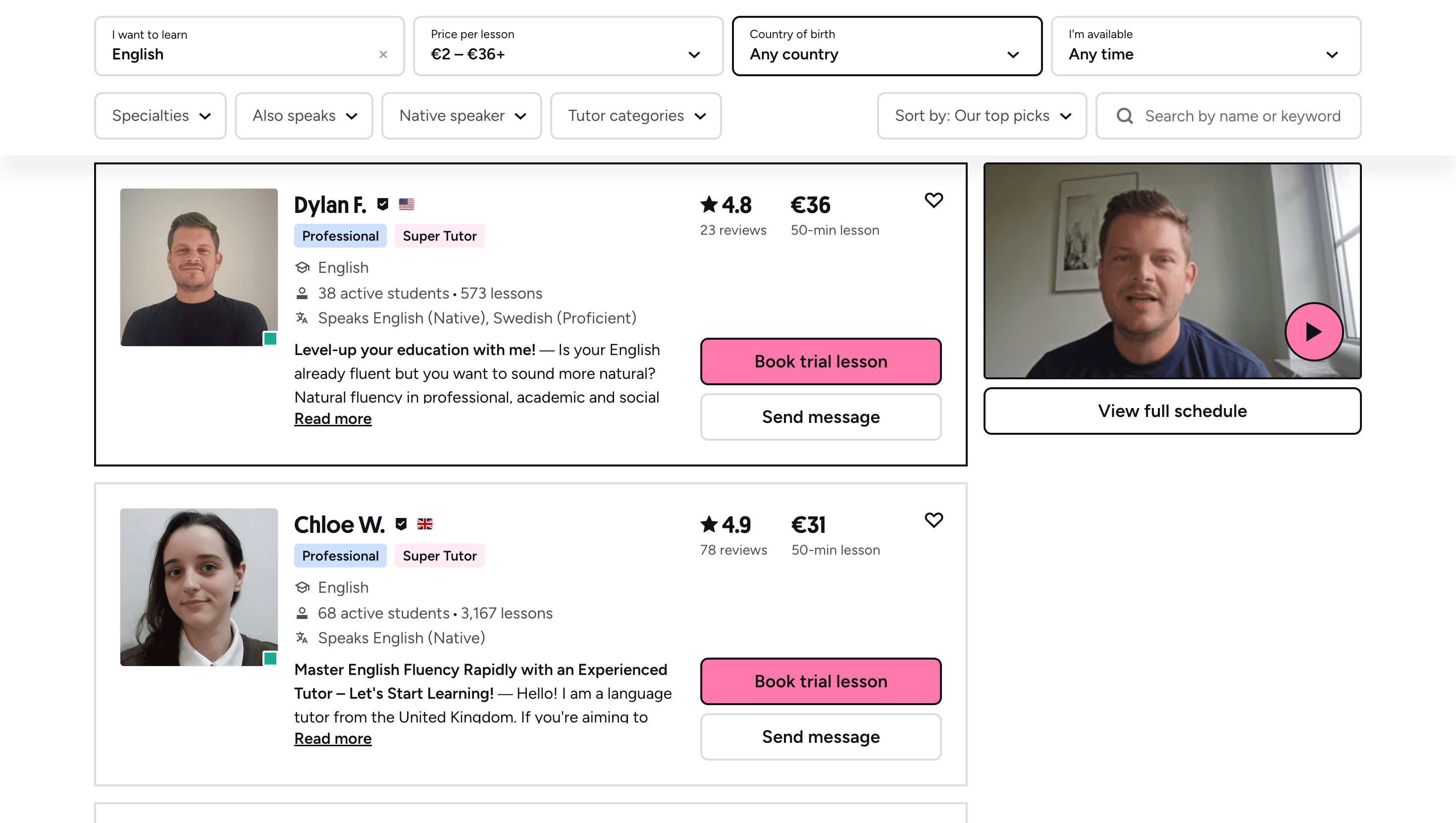
Many learners give up on language learning due to these high costs, missing out on valuable professional and personal opportunities.
That’s why we created Kylian: to make language learning accessible to everyone and help people master a foreign language without breaking the bank.
To get started, just tell Kylian which language you want to learn and what your native language is
Tired of teachers who don’t understand your specific struggles as a French speaker? Kylian’s advantage lies in its ability to teach any language using your native tongue as the foundation.
Unlike generic apps that offer the same content to everyone, Kylian explains concepts in your native language (French) and switches to the target language when necessary—perfectly adapting to your level and needs.
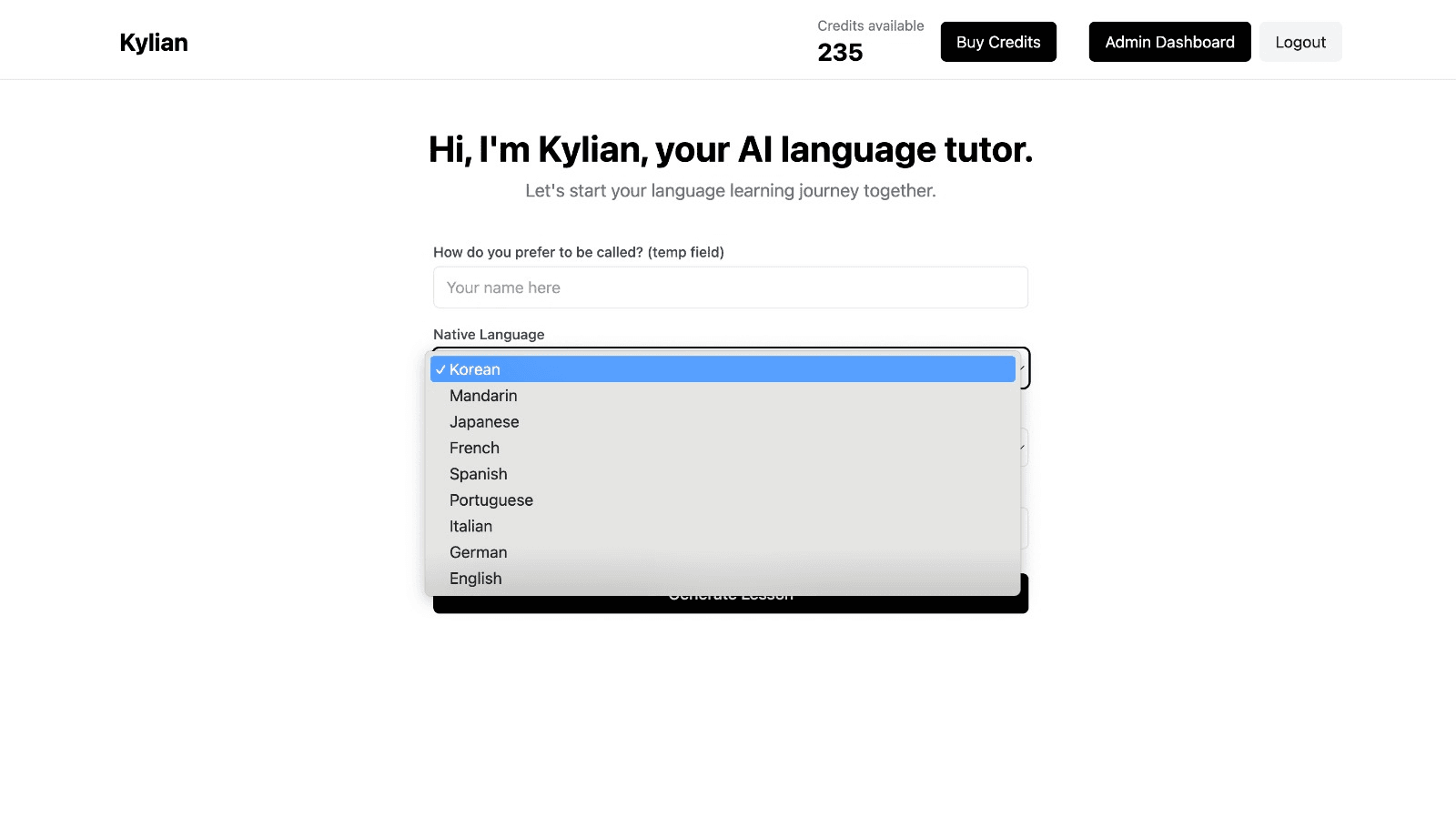
This personalization removes the frustration and confusion that are so common in traditional language learning.
Choose a specific topic you want to learn
Frustrated by language lessons that never cover exactly what you need? Kylian can teach you any aspect of a language—from pronunciation to advanced grammar—by focusing on your specific goals.
Avoid vague requests like “How can I improve my accent?” and be precise: “How do I pronounce the R like a native English speaker?” or “How do I conjugate the verb ‘to be’ in the present tense?”
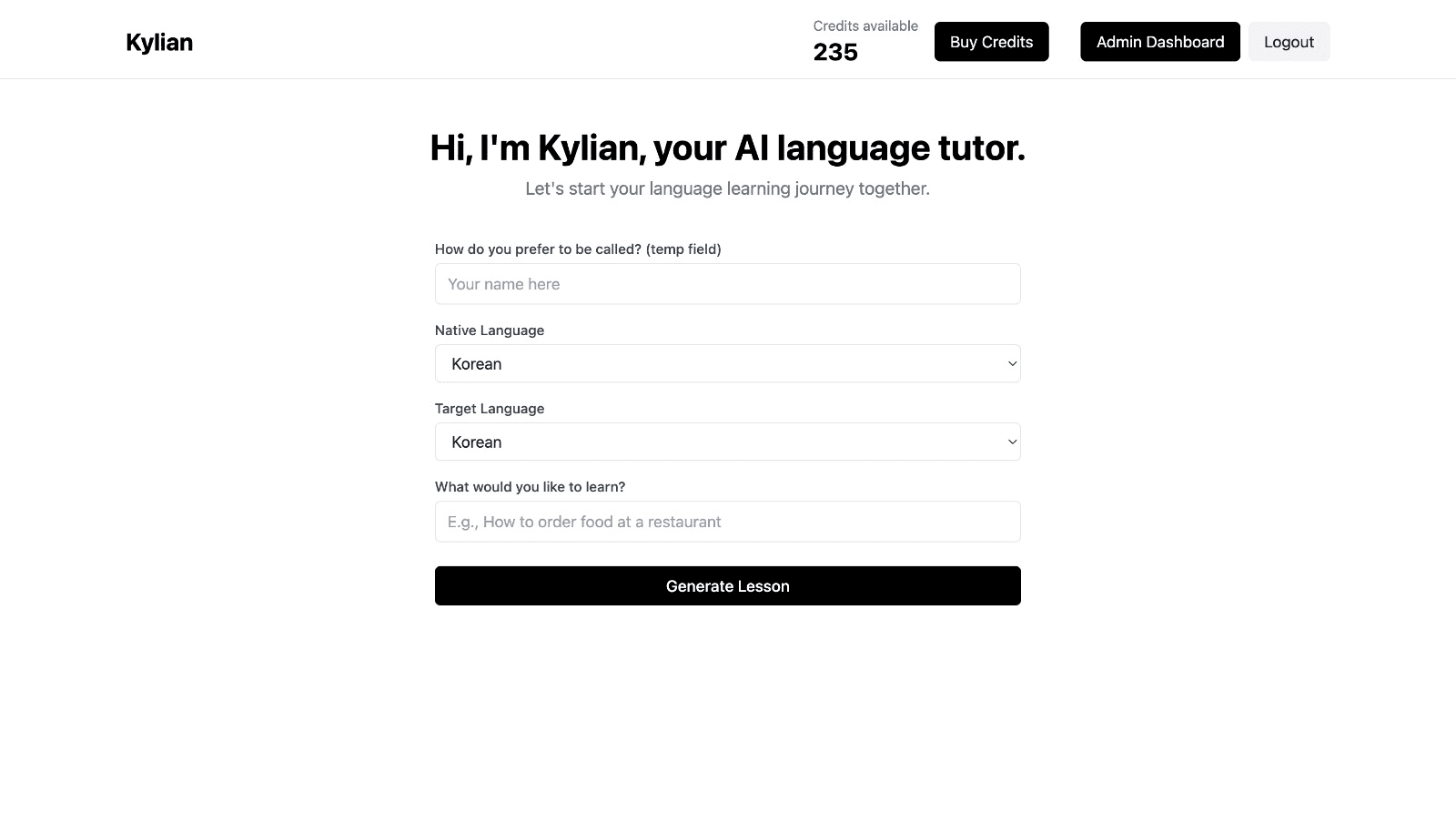
With Kylian, you’ll never again pay for irrelevant content or feel embarrassed asking “too basic” questions to a teacher. Your learning plan is entirely personalized.
Once you’ve chosen your topic, just hit the “Generate a Lesson” button, and within seconds, you’ll get a lesson designed exclusively for you.
Join the room to begin your lesson
The session feels like a one-on-one language class with a human tutor—but without the high price or time constraints.
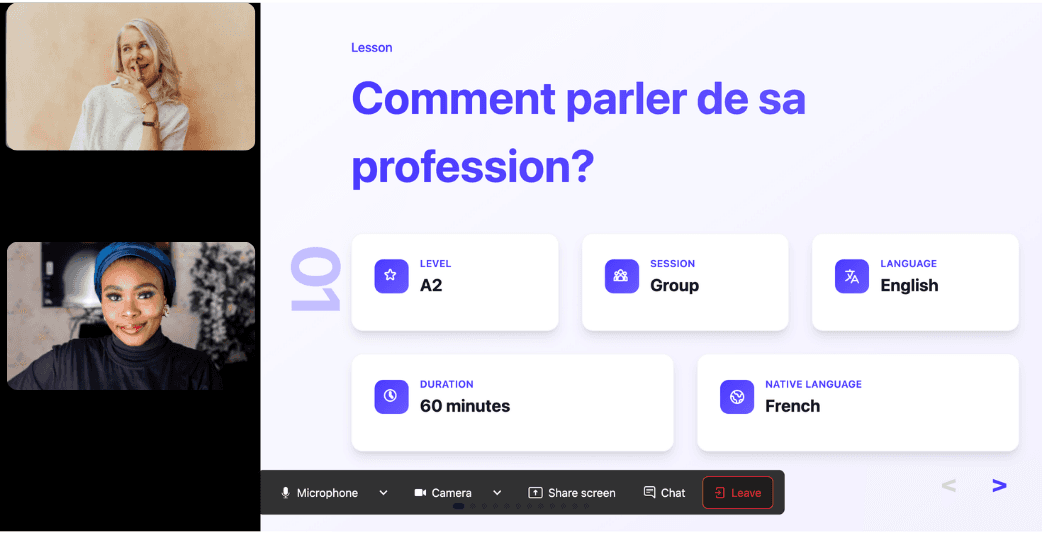
In a 25-minute lesson, Kylian teaches exactly what you need to know about your chosen topic: the nuances that textbooks never explain, key cultural differences between French and your target language, grammar rules, and much more.
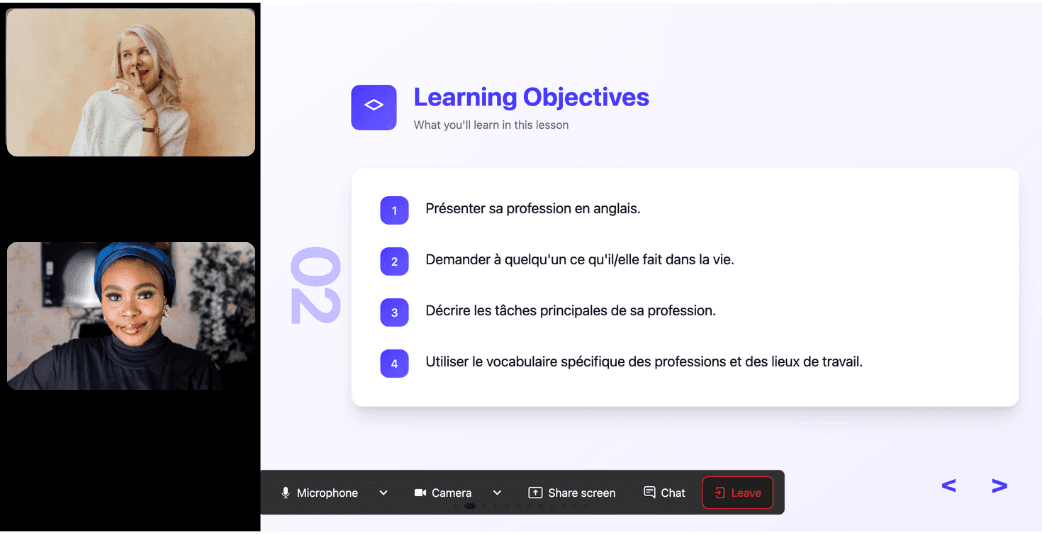
Ever felt frustrated trying to keep up with a native-speaking teacher, or embarrassed to ask for something to be repeated? With Kylian, that problem disappears. It switches intelligently between French and the target language depending on your level, helping you understand every concept at your own pace.
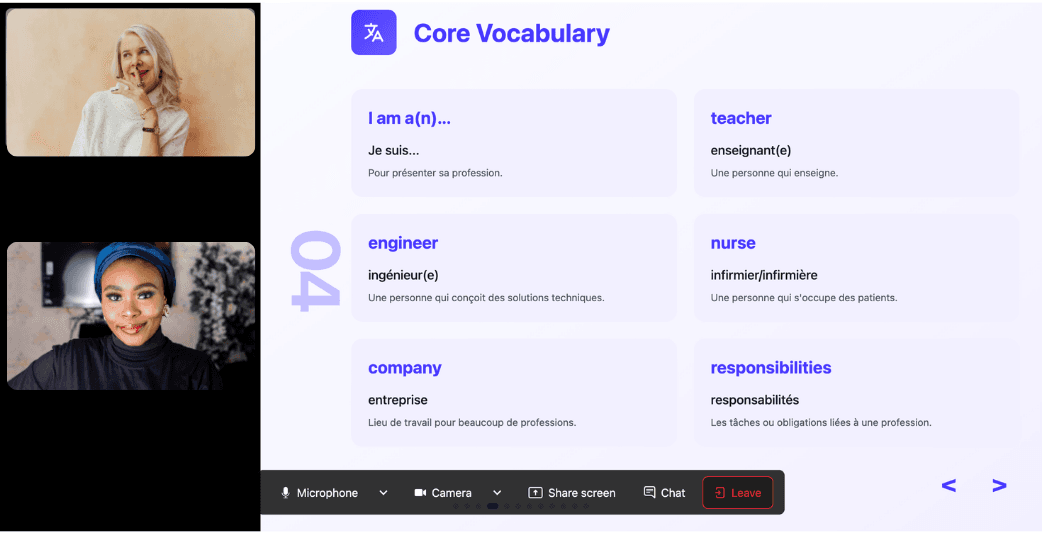
During the lesson, Kylian uses role-plays, real-life examples, and adapts to your learning style. Didn’t understand something? No problem—you can pause Kylian anytime to ask for clarification, without fear of being judged.
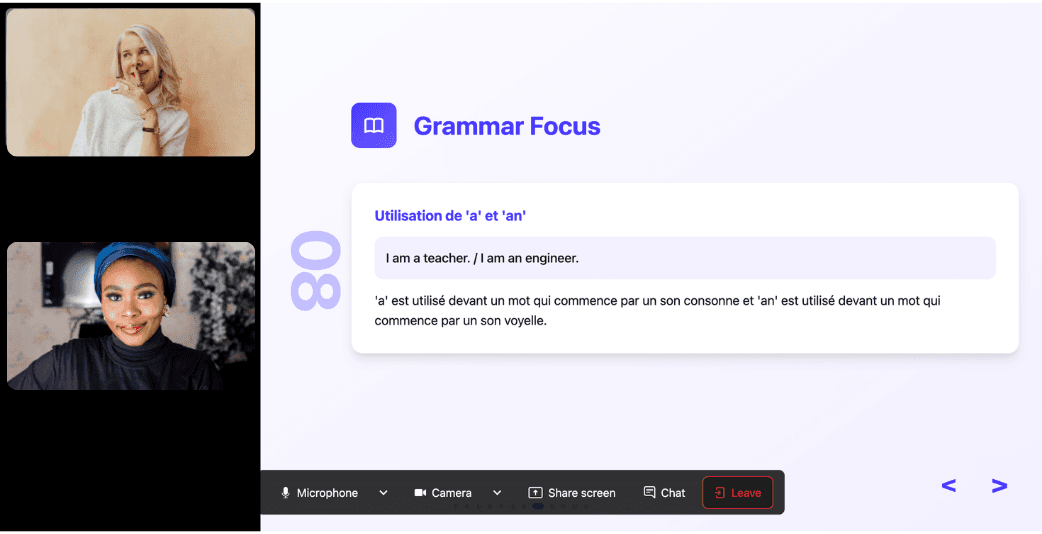
Ask all the questions you want, repeat sections if needed, and customize your learning experience in ways traditional teachers and generic apps simply can’t match.
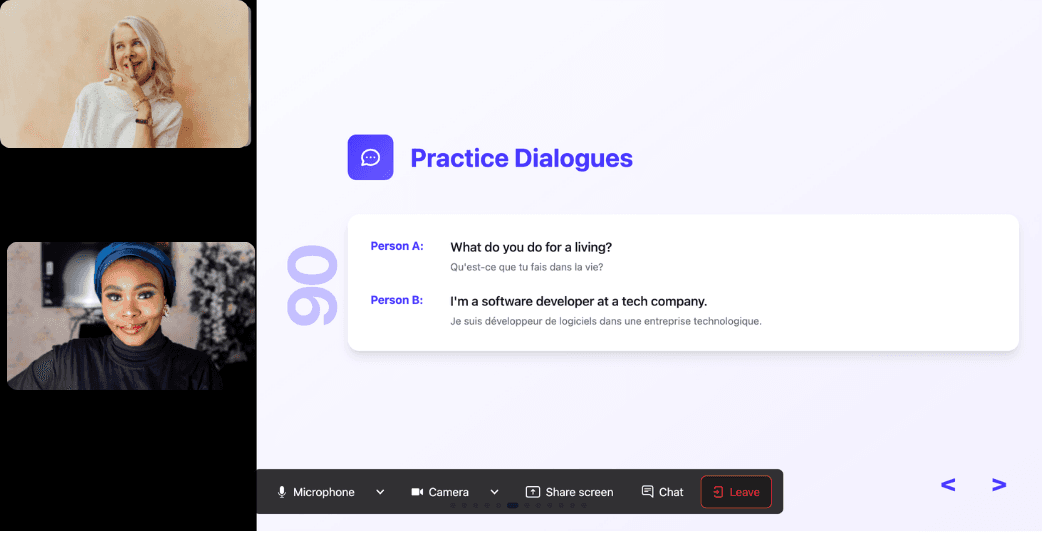
With 24/7 access at a fraction of the cost of private lessons, Kylian removes all the barriers that have kept you from mastering the language you’ve always wanted to learn.
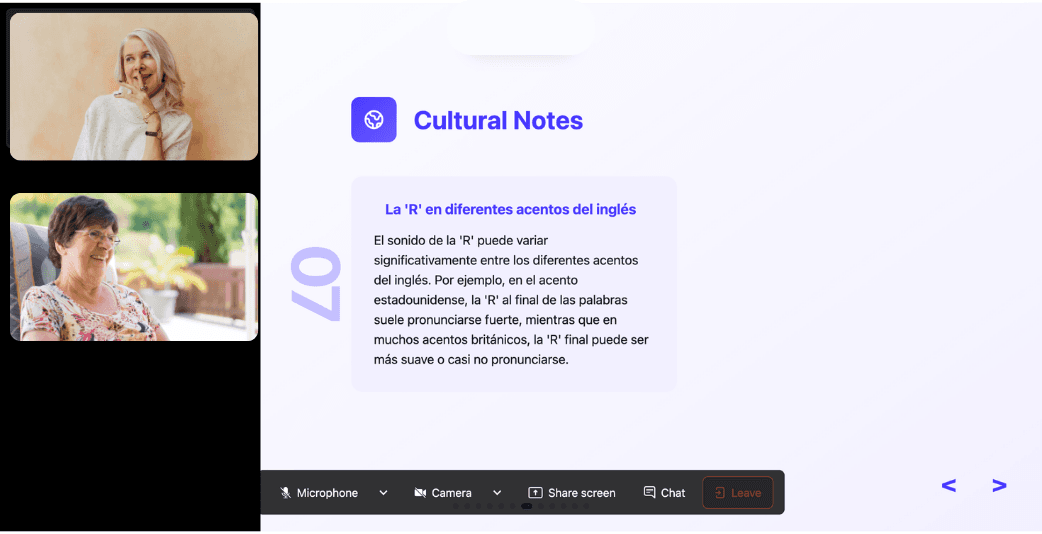
Similar Content You Might Want To Read
![Amid vs During: Grammar Guide [English]](/_next/image?url=https%3A%2F%2Fcdn.sanity.io%2Fimages%2F147z5m2d%2Fproduction%2F3daf487972939cdce5c9dca63213fe4a78c8c5e0-2240x1260.png%3Frect%3D175%2C0%2C1890%2C1260%26w%3D600%26h%3D400&w=3840&q=75)
Amid vs During: Grammar Guide [English]
The distinction between "amid" and "during" represents more than a simple vocabulary choice—it reflects how we conceptualize time, circumstances, and our relationship to events. When someone asks whether to say "amid pandemic" or "during pandemic," they're touching on a fundamental aspect of English precision that affects meaning, tone, and reader comprehension. Both prepositions are grammatically correct in this context, yet they convey subtly different meanings that can significantly impact your message's effectiveness. Understanding this distinction matters because imprecise language dilutes communication, particularly in professional and academic contexts where clarity drives outcomes.

Hall's Cultural Dimensions: Cross-Cultural Business Guide
Successful global business operations require more than just linguistic proficiency. They demand a nuanced understanding of cultural frameworks that shape how people communicate, collaborate, and negotiate. Edward T. Hall, a pioneering anthropologist, developed cultural dimensions that provide essential insights for navigating cross-cultural business environments.

10 Ways to Say "Good Morning" in Korean: Practical Guide
When navigating a new language, understanding proper greetings forms the foundation of meaningful communication. Korean, with its intricate social hierarchy system, offers multiple expressions for seemingly simple phrases like "good morning." These variations reflect Korean culture's emphasis on respect, age-based relationships, and social context. This article explores ten distinct ways to say "good morning" in Korean, categorized by formality level. By mastering these expressions, you'll demonstrate cultural awareness and proper etiquette in your Korean language journey.

When to Use "Horny" in English: Complete Usage Guide
Understanding when and how to use the word "horny" requires navigating both its legitimate linguistic applications and its social implications. This analysis cuts through the confusion to deliver actionable insights about proper usage in contemporary English.
![Past Participle of Upset: Complete Grammar Guide [English]](/_next/image?url=https%3A%2F%2Fcdn.sanity.io%2Fimages%2F147z5m2d%2Fproduction%2F53c67ecdd120bc85bef71090e949f58449b4b106-2240x1260.png%3Frect%3D175%2C0%2C1890%2C1260%26w%3D600%26h%3D400&w=3840&q=75)
Past Participle of Upset: Complete Grammar Guide [English]
The past participle of "upset" is "upset" – unchanged from its base form. This fundamental grammatical truth matters because "upset" belongs to a specialized category of irregular verbs that challenge conventional English conjugation patterns, affecting how millions of English learners construct perfect tenses, passive voice, and participial phrases. Understanding this verb's behavior isn't merely academic. The verb "upset" appears in approximately 2.3% of all English conversations according to corpus linguistics research, making its correct usage essential for fluent communication. Yet its unchanging form creates persistent confusion among learners who expect morphological variation.

Preterite vs Imperfect: Master Spanish Past Tenses
Spanish past tenses present a particular challenge for English speakers. The distinction between preterite and imperfect tenses often becomes a stumbling block for language learners seeking fluency. This comprehensive guide equips you with precise explanations, strategic approaches, and authentic examples to master this fundamental aspect of Spanish grammar.